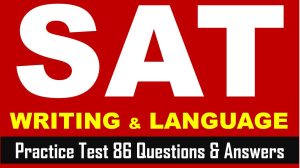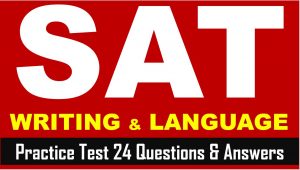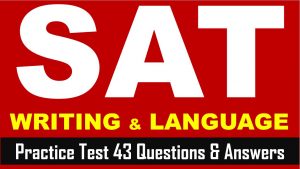Hi SAT Aspirants, welcome to AKVTutorials. As you know SAT (Scholastic Assessment Test) is a standard test, used for taking admission to undergraduate programs of universities or colleges of United States. SAT is developed and published by the College Board, an organization in United States, administered by the Educational Testing Service. Therefore, you need to do practice on SAT Reading Section, SAT Writing and Language Section. In this article, you will get SAT Language and Writing Practice Test 47 with Answer Keys AMBIPi
Instruction:
- In the passage below is accompanied by a number of questions.
- For some questions, you need to think how the passage might be revised to improve the expression of ideas.
- For other questions, you will consider how the passage might be edited to correct errors in sentence structure, usage, or punctuation.
- Some questions will direct you to an underlined portion of a passage.
- Other questions will direct you to a location in a passage or ask you to think about the passage as a whole.
SAT Writing & Language Section Passage
SAT Writing Passage Title: Classifying the Stars
In astronomy, stellar classification is governed by the Morgan-Keenen system, which categorizes stars based on their composition and surface temperature. The origins of this system can be traced back to the work of Annie Jump Cannon, a late nineteenth century and early twentieth-century 1 astronomer. Spending over forty years classifying stars based on their unique spectra of transmitted light. [1]
Beginning early in her life, Cannon demonstrated an exceptional aptitude for the physical sciences. [2] Later, as a student at Wellesley College, Cannon earned a degree in physics and became an expert in spectroscopy: the process by which light is separated into its component wavelengths. [3] During this period, she also took up photography and traveled extensively in order to experiment with the newly invented black-box camera. [4] As a child, she developed an interest in astronomy and purportedly used her attic as a makeshift observatory. 2
Cannon’s background in physics, astronomy, and photography provided her with a unique skillset that 3 will serve ae her well for the rest of her career. After working as a research assistant for a number of astronomers at Wellesley and Radcliffe Colleges, Cannon was hired by Professor Edward Charles Pickering, the director of the Harvard College Observatory. Under Pickering, she classified over 300,000 stars-more than any other human in history-using only a telescope, a spectrometer, and a camera. Using this knowledge, she developed her own classification system that relied on the surface temperature of the stars, which could be approximated using the spectrum of light transmitted from each star. It was said that Cannon could classify three stars a minute and, using a magnifying glass, could classify stars down to the 9th magnitude-sixteen times fainter than 4 humans.
Today, Cannon’s unique classification system is used by countless astronomy enthusiasts around the world. 5 Pickering was succeeded by Harlow Shapley. Shapley once said that Cannon’s contribution to astronomy was “a structure that probably will never be duplicated in kind or extent by a single individual.” Indeed, Cannon’s work has forever shaped our comprehension and perception of the vast and elaborate universe.
SAT Writing & Language Practice Questions
Question No 1
Which choice best maintains the sentence pattern already established in the paragraph?
Option A : No Change
Option B : astronomer, she spent
Option C : astronomer spent
Option D : astronomer who spent
Answer
Show/Hide Answer
Option D : astronomer who spen
Question No 2
To make the paragraph most logical, sentence 4 should be placed
Option A : where it is now.
Option B : before sentence 1.
Option C : after sentence 1.
Option D : after sentence 2.
Answer
Show/Hide Answer
Option C : after sentence 1.
Question No 3
Which choice provides the most effectively transition to the information that follows?
Option A : No Change
Option B : serve
Option C : would serve
Option D : has served
Answer
Show/Hide Answer
Option C : would serve
Question No 4
Which choice provides the most effectively transition to the information that follows?
Option A : No change
Option B : the human eye.
Option C : that of the human eye.
Option D : what can be seen by the human eye.
Answer
Show/Hide Answer
Option D : what can be seen by the human eye.
Question No 5
Which choice most effectively combines the underlined sentences?
Option A : Harlow Shapley, who once said Cannon’s contribution to astronomy was “a structure that probably will never be duplicated in kind or extent by a single individual,” was Pickering’s successor.
Option B : Pickering was succeeded by Harlow Shapley, and Shapley once said that Cannon’s contribution to astronomy was “a structure that probably will never be duplicated in kind or extent by a single individual.
Option C : Pickering was succeeded by Harlow Shapley, and Shapley once said that Cannon’s contribution to astronomy was “a structure that probably will never be duplicated in kind or extent by a single individual.
Option D : Pickering was succeeded by Harlow Shapley, and Shapley once said that Cannon’s contribution to astronomy was “a structure that probably will never be duplicated in kind or extent by a single individual.
Answer
Show/Hide Answer
Option D : Pickering was succeeded by Harlow Shapley, and Shapley once said that Cannon’s contribution to astronomy was “a structure that probably will never be duplicated in kind or extent by a single individual.



